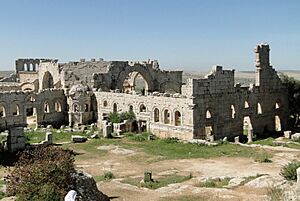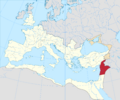Roman Syria facts for kids
Quick facts for kids Provincia Syriaἐπαρχία Συρίας eparchía Syrías |
|||||||||||||||
|---|---|---|---|---|---|---|---|---|---|---|---|---|---|---|---|
| Province of the Roman Empire | |||||||||||||||
| 64 BC–198 AD | |||||||||||||||
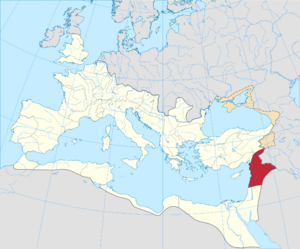 Roman Syria highlighted in 125 AD |
|||||||||||||||
| Capital | Antioch (modern-day Antakya, Hatay, Turkey) |
||||||||||||||
| History | |||||||||||||||
|
• Conquest of Coele-Syria by Pompey
|
64 BC | ||||||||||||||
|
• Province divided into Coele Syria and Phoenice
|
198 AD | ||||||||||||||
|
|||||||||||||||
| Today part of | |||||||||||||||
Roman Syria was an important Roman province that became part of the Roman Republic in 64 BC. A famous Roman general named Pompey took control of it during a war. This happened after he defeated Tigranes the Great, the king of Armenia, who was protecting the Greek kingdom of Syria.
Over time, other nearby areas like Iturea and Trachonitis were added to Roman Syria. By the late 100s AD, the large province was split into two smaller ones: Coele Syria and Syria Phoenice.
Contents
Becoming a Roman Province
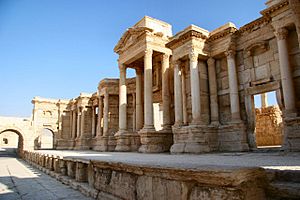
Syria became part of the Roman Republic in 64 BC. This happened when Pompey the Great removed the last Seleucid king, Antiochus XIII Asiaticus. Pompey then chose Marcus Aemilius Scaurus to be the first governor of Syria.
When the Roman Republic changed into the Roman Empire, Syria became an imperial province. This meant it was ruled directly by an official chosen by the emperor, called a Legate. In the early days of the empire, the Roman army in Syria had three legions. These soldiers, along with helpers, protected the border with the Parthian Empire.
Changes in Roman Rule
In 6 AD, Emperor Augustus took control of Judea, Samaria, and Idumea. These areas were combined into the Roman province of Judea. This new province was placed under the direct authority of the Legate of Syria, Publius Sulpicius Quirinius. He appointed Coponius as the first Prefect of Judea.
Later, more regions like Ituraea, Trachonitis, Galilee, and Perea were also put under Syria's control. This happened after the deaths of local rulers.
From 37 to 41 AD, a large part of southern Syria became a separate kingdom. It was ruled by Herod Agrippa I, who was a Roman ally. After Agrippa died, his kingdom slowly became part of the Roman Empire again. It officially became a Roman province after the death of Herod Agrippa II.
Syria's Role in Wars
The Roman forces in Syria were heavily involved in the First Jewish–Roman War from 66 to 70 AD. In 66 AD, Cestius Gallus, the governor of Syria, led the Syrian army to stop a revolt in Judea. However, his legion was attacked and defeated by Jewish rebels at the Battle of Beth Horon. This defeat shocked the Roman leaders.
The future emperor Vespasian was then put in charge of stopping the Jewish revolt. In 69 AD, Vespasian, with the support of Syrian army units, decided to try and become Roman emperor. He defeated his rival Vitellius and ruled as emperor for ten years. His son Titus took over after him.
An old stone inscription found in 1948 tells us about Quintus Coredius Gallus Gargilius Antiquus. He was a governor in the eastern part of the Empire, possibly Syria. Another inscription found in 2016 confirmed that Antiquus was governor of Judea between 120 and 130 AD.
The historian Theodor Mommsen noted that the governor of Syria had great power. He controlled the entire large province and was one of the most important commanders in all of Asia for a long time. Later, in the 100s AD, his power was reduced. Emperor Hadrian took one of Syria's four legions and gave it to the governor of Palestine.
The Province Divides
Syria Splits into Two Provinces
| Provincia Coele Syria ἐπαρχία Κοίλης Συρίας |
|||||||||||
|---|---|---|---|---|---|---|---|---|---|---|---|
| Province of the Roman Empire | |||||||||||
| 198–end of 4th century | |||||||||||
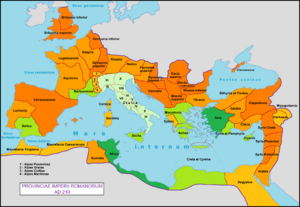 Roman Empire in 210 |
|||||||||||
| Capital | Antioch | ||||||||||
| History | |||||||||||
|
• Established
|
198 | ||||||||||
|
• Disestablished
|
end of 4th century | ||||||||||
|
|||||||||||
| Today part of | |||||||||||
| Provincia Syria Phoenice | |||||||||||||
|---|---|---|---|---|---|---|---|---|---|---|---|---|---|
| Province of the Roman Empire | |||||||||||||
| 198–end of 4th century | |||||||||||||
 Roman Empire in 210 |
|||||||||||||
| Capital | Tyre | ||||||||||||
| History | |||||||||||||
|
• Established
|
198 | ||||||||||||
|
• Disestablished
|
end of 4th century | ||||||||||||
|
|||||||||||||
Emperor Septimius Severus divided the large province of Syria into two new provinces. These were Syria Coele and Syria Phoenice. The capital city for Syria Coele was Antioch, and for Syria Phoenice, it was Tyre.
This division happened because Severus wanted to reduce the power of the Syrian governor. The province had supported Pescennius Niger as emperor, just as it had supported Vespasian before. Severus split the province into a northern part, Coele-Syria, and a southern part, Syro-Phoenicia. He gave two legions to the northern governor and one legion to the southern governor.
From the late 100s AD, many important Syrians became members of the Roman Senate. These included Claudius Pompeianus and Avidius Cassius.
Syria was very important during the Crisis of the Third Century, a time of great trouble for Rome. In 244 AD, a Syrian man named Philip the Arab became the 33rd emperor of Rome. He was from Philippopolis, a city in the nearby province of Arabia Petraea.
Roman Syria faced invasions in 252 or 253 AD. A Roman army was defeated by the Persian King Shapur I at the Battle of Barbalissos. This left the Euphrates river unprotected, and the Persians raided the region. Another similar event happened in 259 or 260 AD. Shapur I again defeated a Roman army and captured the Roman emperor, Valerian, alive at the Battle of Edessa. Roman Syria suffered greatly, with cities being captured, robbed, and destroyed.
From 268 to 273 AD, Syria was part of the Palmyrene Empire. This was a powerful kingdom that broke away from Roman control for a short time.
| The 'Orient' in the time of Septimius Severus c. 200 AD | ||
|---|---|---|
| Coele Syria | Provincia Syria Coele | |
| Phoenicia | Provincia Syria Phoenice | |
| Palaestina | Provincia Syria Palaestina | |
| Arabia | Provincia Arabia Petraea | |
Later Roman Reforms
After the reforms by Emperor Diocletian, Syria Coele became part of the Diocese of the East. Around 341 AD, a new province called Euphratensis was created. It was made from parts of Syria Coele along the Euphrates River and the old Kingdom of Commagene. Its capital city was Hierapolis.
Syria in the Byzantine Empire
After about 415 AD, Syria Coele was divided even further. It became Syria I (or Syria Prima), with its capital still at Antioch. The other part was Syria II (Syria Secunda) or Syria Salutaris, with its capital at Apamea on the Orontes. In 528 AD, Emperor Justinian I created a small coastal province called Theodorias from parts of both provinces.
The region remained a very important province of the Byzantine Empire. It was taken over by the Sasanians between 609 and 628 AD. Then, Emperor Heraclius won it back. However, it was lost again to the advancing Muslims after the Battle of Yarmouk and the fall of Antioch.
The city of Antioch was recaptured by Nikephorus Phocas in 963 AD. Other parts of the country were also taken back. However, a Muslim reconquest by the Fatimid Caliphate happened in the late 970s. This led to the Byzantines losing most of Syria. Still, Antioch and some northern parts of Syria remained with the empire. Other areas were protected by the emperors through local rulers. This continued until the Seljuk Turks arrived. After many attacks, they conquered Antioch in 1084. Antioch was captured again in the 1100s by the Byzantine armies. However, by then, the city was seen more as part of Asia Minor than Syria.
People and Population
The province of Syria had many different groups of people. The rural areas inland were mostly home to Aramaic speakers. These people were descendants of various West Semitic groups who had lived in Syria for a long time. Arabs lived throughout Hauran, Trachonitis, and Emesa, which they controlled. Arabs were also part of Palmyra's population, which included Aramaeans, Arabs, and Amorites.
The Phoenician coast kept a majority of Phoenician-speaking people well into the late 100s AD. Their main cities were Tyre, Sidon, and Berytus. On the other hand, Greeks made up most of the population in Greek-style cities. These included Antioch, Apamea, Cyrrhus, and the Decapolis. These cities had been settled by Greeks under the Seleucid rulers.
Estimates for the total population of the entire Levant in the 1st century AD range from 3.5–4 million to 6 million people. This level of population was only reached again in the 1800s. Cities grew very large, and rural areas also became very crowded. Antioch and Palmyra reached populations of 200,000–250,000 people. Apamea had 117,000 'free citizens' around 6 AD. When you add their surrounding areas and villages, Apamea and Cyrrhus might have had as many as 500,000 people each. The Syrian Coastal Mountain Range, which was hilly and less developed, had a smaller population of about 40,000–50,000 people.
Identity and Culture
The people living in Syria adopted many Greek customs. However, they also kept parts of their Near Eastern culture. How much of the older cultures remained varied across different regions. Some areas showed strong Aramean, Phoenician, and neo-Hittite influences. But many places only showed Greek influences.
Unlike Jews, who shared a common history and identity, Syrians did not have one single cultural or social identity. What brought people together in Roman Syria were the Greek city structures and stories promoted by Roman rule. This suggests that Syrian culture was mostly shaped by Greek and Roman influences. So, the term 'Syrian' mainly described where someone lived, not a shared culture.
Images for kids
See also
- History of Syria
- Ottoman Syria
- Assyria (Roman province)
- List of governors of Roman Syria




